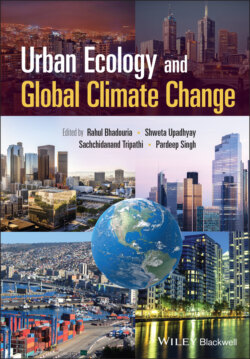Читать книгу Urban Ecology and Global Climate Change - Группа авторов - Страница 23
1.3.2 Impact on Urban Flora
ОглавлениеAs mentioned earlier, urban plant communities are composed of both native and exotic origins with different traits and niches (Lososová et al. 2018). They hold crucial importance in the urban ecosystems by supporting massive biodiversity and providing ecosystems services such as temperature regulation, primary productivity, nutrient cycling, pollution reduction, carbon storage, and recreational opportunities to the human inhabitants (Dallimer et al. 2016; Lososová et al. 2018; Cubino et al. 2021). Studies revealed that climate change acts as a major driver for changes in the plant diversity, community structure, and composition (Lososová et al. 2018; Cubino et al. 2021). Plant species with different traits and origins have been supposed to respond differently to the future climate change. Based on the global climate model predictions for two representative concentration pathways (2.6 and 8.5), Lososová et al. (2018) reported that the perennial herbs and woody trees will respond more slowly to the climate change as compared to the fast‐spreading annual herbs. However, studies revealed that the responses of both native and alien plant species will be similar under changing climate conditions (Lososová et al. 2018).
Different resource conditions such as soil water availability, precipitation, nitrogen deposition, photoperiod length, and CO2 conditions also regulate the plant phenological events (Jeong et al. 2011; Cong et al. 2013). In temperate latitudes, climate change has played a major role in advancing and extending the growing seasons of plants (Menzel and Fabian 1999). Therefore, the projected climate change will alter the future species composition of the urban flora by modulating the temperature and precipitation conditions having direct impact on the plant phenological events (Neil et al. 2014; Lososová et al. 2018). Shifts in vegetation phenological events will have considerable impacts on different ecological functions which lead to the alteration in water, carbon and energy balances, and thus, primary productivity and interspecific interactions (Dallimer et al. 2016). Impact of urbanisation and climate change on the phenological events of birds (migration), amphibians (reproduction), plants (leafing and flowering), and arthropods (appearance and development) has been studied considerably (Grimm et al. 2008; Neil et al. 2010). Similarly, extensive studies have been done to measure the abundance and richness of bee species under changing climate and urbanisation conditions (Neil et al. 2014). A general decrease in bee species abundance and richness has been reported in the urban areas with respect to the climate change conditions. However, mechanistic understanding of these changes on flowering phenology and the pollinator communities is still needed to be explored (Neil et al. 2014). Therefore, for effective management of the urban green spaces, it is critically important to understand how the future plant and related pollinator communities will respond to the combined impacts of urbanisation and climate change conditions (Dallimer et al. 2016).
